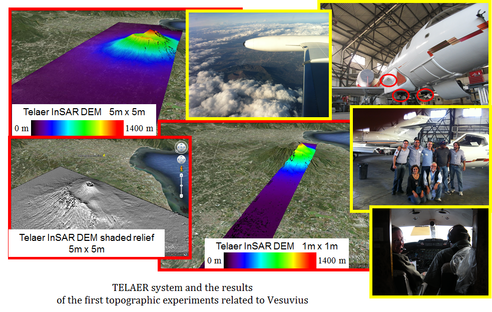 The airborne SAR platforms provide high operational flexibility, overcoming some limitations of satellite acquisitions. As a matter of fact, in some circumstances DInSAR by satellite cannot be fully adequate. Indeed, the orbits described by the satellites used for remote sensing applications do not allow measurements of ground deformation along the North-South direction. In addition, the time interval between two consecutive acquisitions of the same illuminated area on the ground (“revisiting time”) is fixed and does not allow monitoring deformation phenomena occurring on a daily scale, as required in emergency scenarios. Unfortunately, the extension of the DInSAR technique to airborne data is not trivial, due to the so-called residual motion errors that typically characterize the airborne SAR datasets.
The airborne SAR platforms provide high operational flexibility, overcoming some limitations of satellite acquisitions. As a matter of fact, in some circumstances DInSAR by satellite cannot be fully adequate. Indeed, the orbits described by the satellites used for remote sensing applications do not allow measurements of ground deformation along the North-South direction. In addition, the time interval between two consecutive acquisitions of the same illuminated area on the ground (“revisiting time”) is fixed and does not allow monitoring deformation phenomena occurring on a daily scale, as required in emergency scenarios. Unfortunately, the extension of the DInSAR technique to airborne data is not trivial, due to the so-called residual motion errors that typically characterize the airborne SAR datasets.
At IREA, several techniques have been developed to compensate residual motion errors in airborne SAR images. Such techniques have been applied to data acquired by the OrbiSar airborne sensor (operating at X-band) over the Perugia area during an experimental campaign organized in 2004 in collaboration with the Institute of Research for the Hydrogeological Protection (IRPI) of the National Research Council (CNR), the Vesuvius Observatory and the OrbiSat Remote Sensing company. This has allowed the generation of X-band airborne SAR differential interferograms characterized by accuracies of the order of millimeters.
More recently, in order to successfully apply the aforementioned techniques also to Italian sensors, IREA has been involved in the upgrading of the AeS4 TELAER airborne SAR system operating at the X-band (10 GHz) and owned by the Agency for Agriculture Subsidy Payments (AGEA). In particular, CNR has funded (on its own MIUR funding) the upgrading of the TELAER SAR system in the frame of cooperation with AGEA. Moreover, CNR has entrusted IREA for managing all the activities related to such a system upgrading, included the flight-tests. The aim of this upgrading was twofold. First, the system, which was originally equipped with a single TX/RX antenna, has been upgraded to a single-pass interferometric configuration that allows carrying out single-pass across-track as well as along-track applications. Second, a modern inertial navigation system has been acquired for DInSAR applications.
The system upgrading has been completed in January 2013. Subsequently, a flight-test campaign has been carried out over the Somma-Vesuvius volcanic complex, the Campi Flegrei caldera and the Ischia island, Italy, covering an area of about 4000 km2 . The InSAR data processing of the acquired data has been carried out at IREA and has allowed the generation of Digital Elevation Models (DEMs) characterized by accuracies and resolutions on the order of the meter.



